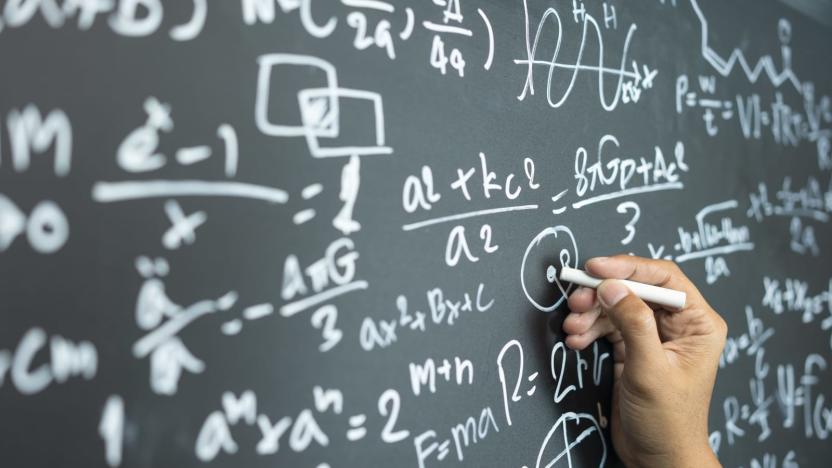math
Latest

MIT solved a century-old differential equation to break 'liquid' AI's computational bottleneck
On Tuesday, MIT researchers announced that they have devised a solution to a vexing computational bottleneck, not by widening the data pipeline, but by solving a differential equation that has stumped mathematicians since 1907.

Duolingo is expanding into math lessons and brain training
It's moving beyond language learning for the first time.

Hitting the Books: How winning the lottery is a lot like being re-struck by lightning
Fractions, probabilities and statistics govern the outcomes of our daily lives but as James Zimring explores in his new book, Partial Truths, numbers can lie.

Here’s how to deal with those badly written equations you find online
It's an easy social media trick, and one you can avoid with some high school math.

Duolingo is adding a family plan and five more languages
The company is planning to release a math-learning app next year.

The best online STEM resources, according to a veteran teacher
After the schools shut down last week, my social media feeds and inbox lit up with color-coded homeschooling charts and agonizingly long lists of everything I should use to educate my kids. Fear, panic and an overwhelming sense of grief settled over me as I considered not only how I was going to explain what was happening to my curious kindergartener and second grader but also how we were going to manage working, schooling, living and staying sane and healthy in our tiny condo for the foreseeable future. As veteran teachers, my husband and I vowed to maintain normal as best we could. We'd stay virtually connected to family and friends and let the kids play and be bored and eat cookies and watch movies and attempt whatever work their school sent home. To calm myself, I composed my own non-exhaustive list of resources, called "Things I might actually use if the internet doesn't die" and sent bits of it to a few friends, who exhaled relief and gratitude. "Thanks," they said. "I might actually use these!" Here it is, reconstituted. I hope it lets you exhale too.

Hitting the Books: The Y2K bug could come back sooner than you think
Welcome to Hitting the Books. With less than one in five Americans reading just for fun these days, we've done the hard work for you by scouring the internet for the most interesting, thought provoking books on science and technology we can find and delivering an easily digestible nugget of their stories.

Facebook taught its AI to speak math
I speak two languages, English and Bad English. My understanding of math is significantly worse. In fact, I had to redo Calculus 2A four different times in college in order to graduate, mostly because I could never properly calculate a ladder's rate of acceleration as it fell away from a wall. You know, the sort of theoretical quandaries that really matter in our day to day lives.

Papercraft-inspired math turns any sheet into any shape
You might not need exotic manufacturing techniques to produce custom-shaped objects. If Harvard scientists have their way, you could start with little more than a sheet and some math. They've created a math framework that borrows from the Japanese papercraft technique of kirigami (which uses strategic cuts to produce art) to transform any sheet into any shape. Effectively, it involves designing backwards -- the intended shape is the last part of the process.

Hitting the Books: How calculus is helping unravel DNA's secrets
Welcome to Hitting the Books. With less than one in five Americans reading just for fun these days, we've done the hard work for you by scouring the internet for the most interesting, thought provoking books on science and technology we can find and delivering an easily digestible nugget of their stories.

'Hidden Figures' will be made into a TV series
Hidden Figures did a lot to highlight the unheralded black female mathematicians who played a key role in the early NASA space program, and it proved a commercial success to boot. So much of a success, in fact, that it could soon extend to TV. Variety has learned that National Geographic is developing a series "inspired by" the Hidden Figures movie, which in turn was based on Margot Lee Shetterly's book. The show is still very in development and isn't guaranteed to get a commitment, but it's executive produced by Peter Chernin and Jenno Topping, both of whom handled the movie.

'Hidden Figures' celebrates black women who led the Space Race
Hidden Figures tells the story of Katherine Johnson, Dorothy Vaughan and Mary Jackson, three black women who played crucial roles in one of NASA's finest hours: launching an American into orbit for the first time. As the film's first trailer shows, their story is not only important, it's long overdue.

Largest-ever math proof chews up 200TB of data
You've probably been asked to prove a math solution at some point, but never like this. Researchers have created the world's largest math proof while solving the Boolean Pythagorean triples problem, consuming a whopping 200TB of data -- the previous record was 'just' 13GB. The sheer size came from having to consider the sheer range (nearly 1 trillion) of possibilities involved in coloring integers. You could technically use a 68GB compressed version at home, but it'd take about 30,000 hours of processing time to crunch the data.

Point your phone at an equation and Mathpix will solve it
Math isn't everyone's strong suit, especially those who haven't stretched that part of their brain since college. Thanks to the wonders of image recognition technology, we now have Mathpix, an iOS app that lets you point your phone camera at a problem and calculates solutions in seconds.

Quantum computer revolves around just 5 atoms
It's no mean feat to find the factors of a very large number -- even a supercomputer can take years to find all the multipliers. However, MIT researchers have found a way to clear this massive hurdle. They've built a quantum computer that discovers number factors using just five atoms. Four of the atoms are turned into logic gates using laser pulses that put them into superpositions (where they maintain two different energy states at once), while the fifth atom stores and delivers answers. The result is a computer that not only calculates solutions much more efficiently than existing quantum systems, but scales relatively easily. Need to get the factors for a larger number? Introduce more atoms.

Trippy art project has you exploring fractals in virtual reality
Fractal art can already be mesmerizing when you're staring at a 2D picture, but artist Matteo Zamagni has found a way to kick things up a notch. His Nature Abstraction art project has you diving into 3D fractals thanks to both an Oculus Rift virtual reality headset and the almost psychedelic imagery from Google's neural network-based Deepdream. The result, as you'll see below, is rather hypnotic -- you're floating through formula-based shapes that are at once familiar and completely alien. Zamagni sees it as a way to challenge the accuracy of your perceptions. You're sadly too late to see this installation in person (it was part of an exhibit at London's Barbican this August), but here's hoping that it resurfaces... it looks like a wild mind trip.

Animated code art uses all of its colors just once
You probably know that the screen on your computer or phone can display millions of colors, if not more. However, have you wondered what it would look like if you tried to represent all of those colors in a single piece of art? Well, you're looking at it. Qubit researcher and math guru Mike Swarbrick Jones has posted a code-driven animation that shows all the colors in a 24-bit RGB palette exactly once. The technique (which relies on mapping colors to voxels, or 3D pixels) produces a kind of "rainbow smoke" that, as you can see in the clip below, is rather hypnotic -- it's tempting to watch it on a loop and meditate. While this won't produce a masterpiece, it's proof that a good idea and the right calculations can lead to some truly eye-catching (not to mention mind-bending) visuals.

PBS explains the magical math behind 'No Man's Sky'
No Man's Sky is impressive. It's a mind-bogglingly massive game and from what we've seen, it's pretty to boot. But enough about that -- let's talk about math. Specifically, the math that makes this game possible. The YouTube channel PBS Game/Show has collected the numerical information that makes No Man's Sky tick and presents it in a lovely, straightforward fashion for everyone to enjoy. No Man's Sky lead Sean Murray makes a few appearances in the video, of course, and we got a one-on-one, hands-on demo of the game with him during E3. Suffice it to say, 10 minutes isn't long enough to properly enjoy No Man's Sky -- but a lifetime probably won't be long enough, either. See for yourself below.

'A Beautiful Mind': mathematician John Nash dies aged 86
Dr. John Nash, the Nobel Prize-winning mathematician whose work included noncooperative game theory, has died aged 86. Known as Nash equilibrium, the theory is used in a broad range of fields, including economics, other social sciences, evolutionary biology as well as influencing computing and artificial intelligence. His work and life were turned into the film A Beautiful Mind, starring Russell Crowe, which won an Oscar for Best Picture in 2001, also putting focus on the stigma of mental illness. Nash's famed work in math and other fields extended beyond the game theory work that won him the Nobel Prize.

Math explains why beating 'Tetris' is basically impossible
You're never going to beat Tetris. Sorry. You might be asking why I'm so pessimistic and even though that's perfectly natural, PBS' Game/Show will back me up here. While the seven multicolored falling bricks (officially called "tetrominoes") all fit together pretty nicely, they only occupy a space that's eight tiles wide when fully combined. Coupled with the size of the playing space -- the "well," as it's called, is ten tiles wide -- there's always going to be room for screw-ups that are out of your control. There's a ton of math, studies of probability and statistics to explain it all, too. As host Jamin Warren tells it (citing a research paper from 1996), failure is due in no small part to how the "bag" randomly generates pieces that're dropping.








